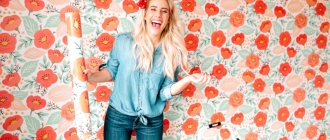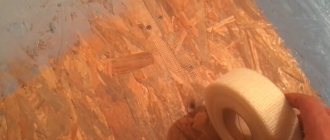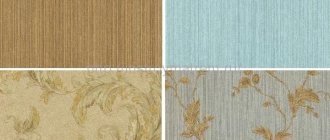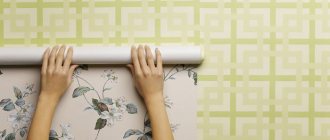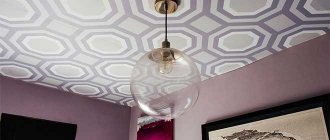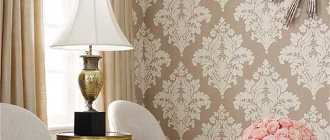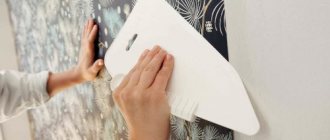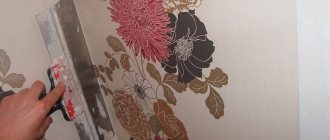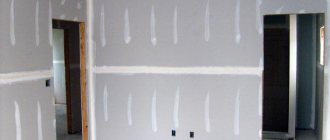Features of the hallway
How to beautifully hang wallpaper in the hallway? Photos offered by interior professionals help beginners understand where to start gluing wallpaper in the hallway.
Attention! Even for those who try to keep the hallway clean and tidy, dust and dirt will accumulate in this room.
That is why, when selecting wallpaper for the hallway, it is necessary to choose practical finishing materials.
Basic rules for wallpapering
Pasting wallpaper, no matter what it is made of, is carried out according to certain rules. We have collected the most important ones. Let's look at how to glue wallpaper for beginners.
Where to start wallpapering a room
In the question of where to start gluing wallpaper in a room, you cannot act at will. This is wrong if you have to work with simplex. This is the name of a single-layer paper finish. The joints of such stripes are quite noticeable. Therefore, gluing begins from the window and moves from it in different directions. Other types of canvases can be glued similarly or other patterns can be used. For example, “circular”. In this case, the strips are glued around the perimeter of the room, returning to the place from which work began.
The circular pattern means that the first sheet can be glued almost anywhere. However, such areas are most often chosen.
- Window. This option is traditionally used.
- Corner. Choose anyone. Be sure to use a plumb line to draw the vertical line. This is a guide for gluing.
- Door. The door frame will serve as a vertical guide.
Sometimes they do things differently. Draw a vertical line on any section of the wall. From this place they begin to stick. This option is good when you are sure that the picture will match exactly. But it doesn't always work out that way. Therefore, the optimal solution would be to stick it from a corner, window or door. Here the slight discrepancy will not be so noticeable.
Instagram kleim_oboi Instagram remont_oboi_krymsk
Applying glue and wallpapering on flat areas of the wall
The gluing technology for different types of canvases is slightly different. We have prepared general instructions for hanging wallpaper yourself.
- We outline a vertical on the base that we will focus on. For accurate marking we use a plumb line.
- We measure the height of the wall. Cut off the first strip. Its height should be equal to the measurement obtained, but it is better to leave a small allowance of 5-6 cm.
- We cut out the remaining canvases, combine the design, laying them out on the floor.
- Preparing the adhesive composition. We do this exactly according to the instructions on its packaging.
- Lay out the strip on the floor. Apply glue to half the sheet on the back side. It is convenient to apply with a roller or brush. Apply the edges with a brush. Fold the spread strip in half without fixing the fold. We do the same with the second half of the sheet.
- Leave the coated material for impregnation. For different types of fabrics, the impregnation time is different; it must be clarified by the marking on the packaging. On average, single-layer paper simplex is impregnated in 1-2 minutes, dense duplex in 7-8 minutes, vinyl in 8-10 minutes. Glue is not applied to the non-woven fabric; it is applied only to the wall.
- Apply a layer of adhesive to the base. The glue strip should be slightly larger than the one you plan to glue.
- Open the top half of the sheet without touching the folded bottom half for now. We place it on the base, applying one edge to the vertical marking. Press the strip against the wall so that it stays in place.
- Straighten the bottom part. We check that it does not move. Smooth the canvas with a spatula or roller using movements in the direction from the middle to the edges or from top to bottom. There should be no air bubbles left. Using a sharp knife, trim off excess material from above and below.
The remaining strips are glued in the same way. Important point. Before starting work, close the windows in the room to prevent drafts. Otherwise the decor will come off. How long you can’t open windows after wallpapering depends on the condition of the finish. When it is completely dry and straightened, you can ventilate the room. On average, it should remain closed for a day.
Original ideas
Don't know what wallpaper to put in the hallway? First, take a closer look at dark wallpaper to decorate your hallway.
Advice! If you have a narrow and long corridor in the hallway, it is better to purchase light washable vinyl wallpaper for it.
Let's talk about how to wallpaper the hallway with different wallpapers. With the help of dark wallpaper, you can achieve a visual reduction in the space of the hallway, so it is better to choose a combination of several types of wallpaper at once. It is quite possible to paste the corridor with different finishing materials, for example, dark canvases in the lower half of the corridor, and for the upper part it is better to choose dark wallpaper.
The corridor in many city apartments is small in size, therefore, when discussing which wallpaper is best to glue in the hallway (see photo below), you can opt for light wallpaper that has a large print.
Rules for gluing
Previously, when wallpaper was only paper-based, they were overlapped. This was due to the fact that the material easily tore when they began to adjust the canvas. To make the joints less noticeable, gluing was carried out from the window (how to glue wallpaper - from the window or from the door?). Nowadays, wallpapers are made from various materials that are more durable, so there is no need to overlap them. But, all the same, choosing a place for the first piece of wallpaper is an important undertaking.
In the room
Pasting in the room is done in a circle . The first sheet is pasted, then the second, and so on, until the moment of joining with the starting sheet comes. When doing work in this way, it is impossible to accurately calculate that the last sheet fits the initial one without excess. At the same time, the accuracy of matching the pattern is also lost.
So that the defect is not conspicuous and less noticeable, the starting point is chosen in a place hidden from view. It can be the door to the room, the space behind the furniture, or a window opening.
- It is advisable to protect the floor from getting glue on it. To do this, polyethylene is spread on it. The furniture is taken out or covered too.
- Measure the height of the first sheet and cut it off. They do this with a margin so that it is possible to adjust the drawing. The sheet is spread on a clean floor surface and pre-prepared glue is applied to it.
- It is very important to glue the first canvas strictly vertically, since the even position of the remaining cuts depends on it. You can measure an even vertical using a building level, plumb line or laser level. The latter tool, although expensive, is easy to use and more accurately determines the evenness of the vertical.
In the corridor
In the hallway and corridor, work is carried out as follows. There are usually no window openings in this room. The most inconspicuous place to look is the front door and the space above it. It is from here that you should start gluing wallpaper, and then in a circle, returning to the door on the other side.
Attention: If there are several doorways in the corridor, any of them can be the starting point.
It is believed that a window opening is more vertical than corners in the same room or a doorway. And the curtains and curtains located there distract attention from the wallpaper. Therefore, the window is often used as the starting point for wrapping . The first sheet of wallpaper can be glued to the side of the window opening or on top, and then the following sections are glued in a circle. If the first strip is located above the window, then its verticality is checked using a tool.
In the event that the wallpaper is still glued with an overlap, then the work should be carried out exactly from the window. This way the overlaps between the cuts will be less noticeable.
Types of finishing materials for the hallway
What kind of wallpaper should I use in the hallway? Photos of numerous options, tips on where to start repairs are presented in the video fragment
Vinyl wallpaper is a modern finishing material that will help you beautifully decorate even a small or long corridor.
Vinyl materials are available in a range of prices. Manufacturers offer a wide range of colors and a variety of prints, so everyone has the opportunity to choose wallpaper according to their taste preferences. Thanks to the relief coating, such materials have a certain texture that allows you to hide minor defects on the walls.
If you don’t know what wallpaper to glue in the hallway (photos of the finished hallway interior can be found on the Internet), keep in mind that it is better not to choose liquid wallpaper for the hallway. The reason is the instability of such materials to high humidity.
Attention! Having chosen liquid finishing materials for the walls for the corridor, you will have problems with carrying out wet cleaning in this room.
The photo shows designers' advice for those who don't know what wallpaper to stick in the hallway. Professionals consider the use of natural finishing materials for the corridor to be an interesting solution. You can glue, for example, bamboo sheets in the corridor. It is these that professionals consider to be the fashion trend of the latest season.
They fit perfectly into any interior style and help achieve maximum naturalness after all finishing work is completed. The photo shows how to glue bamboo wallpaper in the hallway. It is better to start from the corner of the room so that the joints between the individual canvases are not visible.
Attention! Such finishing materials will help you create an excellent image in the corridor, but the cost of bamboo wallpaper is quite high, you will have to spend a lot of money.
Paintable wallpaper is a good option for decorating the walls in the hallway. Professionals consider their main advantage to be the ability (pictured) to change images in a matter of hours, without removing the canvas from the walls to do so. High-quality paintable canvases can withstand up to ten repaintings.
It is better to glue such canvases with a master who knows exactly where it is best to start the work, what kind of materials should be taken in order to carry out high-quality finishing work.
How to glue wallpaper in a room with a suspended ceiling
Before you start gluing wallpaper in a room with a suspended ceiling, you need to carry out preparatory work - remove the furniture, protect the edges of the ceiling covering with masking tape. This will prevent any adhesive or primer from getting on the film or fabric. If the ceiling profile is attached to old wallpaper, you need to make a neat cut along the edge of the finishing material. We protect the ceiling with a wide roller and draw a line with a stationery knife. The cut should be smooth and clear. After this, we wet the old wallpaper and remove it from the wall.
We clean the walls from dirt to improve the quality of adhesion of the wallpaper to the surface, and prime the base. This will avoid unnecessary consumption of glue and will prevent the wallpaper from getting dirty. We prime the area near the ceiling as carefully as possible, since dried drops will be difficult to remove.
If the ceiling is framed with a baguette, you can cut off the old wallpaper along its line and stick new ones overlapping. After this, the excess material is trimmed with a stationery knife. Be sure to use a wide spatula at this point. Any careless movement can lead to cuts in the tension sheet and its complete damage.
Fashionable options for the corridor
Non-woven fabrics are also in demand among interior professionals. They have a strong structure, so they can be glued in the corridor.
Vinyl materials can be considered an excellent combination of quality and reasonable price; you can glue such canvases without fear that any problems or difficulties will arise during operation. The photo shows an example of what finishing materials are suitable for decorating a corridor. You shouldn’t give up textile materials, for example, linen.
Advice! Among the latest interesting options for decorating walls in the corridor, professionals highlight jute and velor finishing materials.
If you don’t know what kind of wallpaper would be best for your hallway, try glass wallpaper or silk-screen printing.
How to prepare walls for wallpaper
If necessary, the surface is plastered to remove unevenness. Then the primer is applied on top of the plaster layer. It is convenient to do this with a roller, and the corners are treated with a brush. Do not allow any uncovered areas to remain. Pass the roller from bottom to top.
To apply putty, use a wide spatula. All sinks are filled with solution. The same must be done with cracks if they appeared over the years of the building’s service. Wallpaper should be glued correctly on a completely flat surface without bumps or depressions.
If it is necessary to apply a thick layer of plaster mortar, a special mesh is first attached. After the primer has dried, which will take 10-15 hours, it makes sense to cover the wall with a weak solution of wallpaper glue. To do this, take about 300 grams of powder (granules) or two glasses of PVA per 10-12 liter bucket of water.
Repair in a small corridor
In such a room, you need to glue only those finishing materials that will help visually expand the space. You need to start by selecting a pattern on the trellis. Professionals advise choosing canvases with frequent and small patterns, as well as tapestries with large prints.
Advice! A good option for a small corridor would be to purchase canvases with an unusual geometric image.
After you decide on the pattern, you need to start choosing the color of finishing materials for the corridor. If its dimensions are too modest, dark shades will be inappropriate, they will further reduce the size and make the hallway uncomfortable and ugly. The photo shows an option for decorating the hallway with light finishing materials.
Among those colors that can be considered ideal for a given room, professionals call olive, blue, and gray tones. All of them are considered cool colors; they help bring additional freshness into the corridor, creating a feeling of airiness and freedom.
If, despite the warnings of the experts, you still choose liquid wallpaper, you must be careful when using it. In the photo you see where you need to start work in order to get an aesthetic coating on the walls. It is the external attractiveness that forces many property owners to choose liquid trellises for corridor walls.
Where to start repair work? First, we recommend that you familiarize yourself with the composition of liquid materials. They contain glue, a certain dye, and also contain natural cotton or cellulose fibers.
Among the many advantages of such decorative coatings, first of all, craftsmen highlight the possibility of application to the surface without creating joints between individual layers. It is this feature that for many property owners becomes the basis for their purchase.
To apply them to the wall, you need to dilute the proposed composition with water in the proportion specified by the manufacturer of the materials. Due to the presence of natural fibers in the mixture, the finished trellises have excellent antistatic characteristics.
How to put wallpaper on wallpaper
This is not the best solution, however, in some cases it is possible. So, if the old strips are thin and well glued to the base, you can glue new ones on top of them. But then you need to choose the right glue. It must be of high quality and prepared exactly according to the instructions. The reliability of fixing the new decor depends on this. And one more piece of advice. In order not to spoil the coating with colored stains, you need to test the dyes of the old canvas.
To do this, run a damp sponge over it several times. If the pigment is unstable, color streaks will appear. Then, before gluing, you need to wash and dry the base or treat it with a special compound that prevents stains from appearing. Do not try to stick decor over vinyl or any textured coating. In the first case, the glue will not be absorbed into the thick film, in the second, all the unevenness of the base will appear on the new design.
Briefly about the main thing
When choosing wallpaper for the hallway, you need to take into account the size of the room, the general style of the interior of the house and the features of use. When choosing a material, you need to rely on those canvases that last a long time and are not afraid of moisture.
When choosing colors, patterns and styling, you need to remember that light shades are usually suitable for small corridors, and dark shades for large ones. The direction of the pattern can also change the perception of the room; wallpaper with vertical stripes will make the corridor taller.
Ratings 0
Choice by style
What wallpaper to choose for a small hallway can be determined after familiarizing yourself with the main styles. It is important that the corridor fits organically into the interior of the entire house. It is also worth considering that the choice of style depends on the dimensions of the room.
Classic for the hallway
Manufacturers' assortment includes many options for classic-style canvases. Some designers also practice combining with wood, when, for example, the lower part is covered with panels, and the upper part is covered with wallpaper.
As for materials, paper or fabric wallpaper is usually used in the classic style. Depending on the area, structure is important. For small corridors, it is better to choose wallpaper with a smooth glossy surface, because they create the effect of visually increasing the area.
Classics in the interior of the hallway Source dizainexpert.ru
Scandinavian hallway
Scandi is a popular interior style today, which is also used for corridors. To stick to it, you need to choose wallpaper in light colors and with a simple pattern. The style personifies calm, and light colors will visually enlarge the corridor.
Video description
Current wallpaper designs for the corridor are shown in this video:
White
A bright and clean room always creates a good impression. White color is suitable for any design. But when using it, it is better to take wallpaper that can be cleaned with water or soap solutions.
Beige
Another bright option for the hallway, which can visually enlarge the room. But it has the same disadvantage as white - it requires regular and careful care.
Beige color expands space Source dizainexpert.ru
Black
If we talk about small corridors, then black color will not work for them, because the room will seem even smaller. But for large houses, this is an excellent option for emphasizing other elements. Another advantage of black is that dirt is less visible on it.
Blue
As practice shows, blue goes perfectly with natural wood, so blue wallpaper is suitable for combined walls with wood panels or for the background of furniture. Moreover, they look great in both large and small hallways.
Blue color is a bold and original solution Source dhoumm.co
Grey
It can only be used in loft style to imitate concrete, but in other rooms it looks a little boring. But everything changes when using combinations and patterns, because gray goes better than other colors with all shades.
Tricks
The vertical arrangement of wallpaper will help refresh the interior and add a touch of innovation. This visually lengthens the hallway, and in combination with horizontally glued plain ones it gives an interesting effect.
If the hallway is small and patterned wallpaper looks too bulky, you can choose different wallpapers, but of similar shades. Soft transitions look gentle and stylish.
Recently, the use of photo wallpaper in combination with conventional wallpaper for walls has become relevant. In a cramped hallway, you can use photo wallpaper with scenes that visually lengthen and expand the space. For example, a view of the sea, a city at night or scenes with landscape spaces will not only create the effect of a realistic continuation of space, but will also saturate the room with new colors.
The design of combined wallpaper for the hallway is possible even when combining several techniques in one interior. It all depends on your imagination and capabilities. And in order for the finished interior to please you and your guests for as long as possible, make sure that during the gluing process all the features of the room and the materials themselves are observed.
Preparation
Choosing a pattern, material and purchasing wallpaper is only the beginning of the work (find out how to choose good wallpaper here, and how to choose the material and color of wallpaper is written here). The main and painstaking work lies ahead.
If wallpaper has already been pasted on the wall, then it must be removed and the surface prepared for cosmetic repairs. A few tips will help you get rid of the old coating:
We invite you to watch a video about preparing walls for wallpapering:
Where should we start?
This puzzled everyone who was faced with wallpapering. The starting point must be determined before pasting. Professional builders advise taking into account what type of lighting is in a particular room. When determining where to start gluing, it is not taken into account how the wallpaper will be glued, since they are no longer overlapped. Here are the four most common options for placing the first piece of wallpaper:
